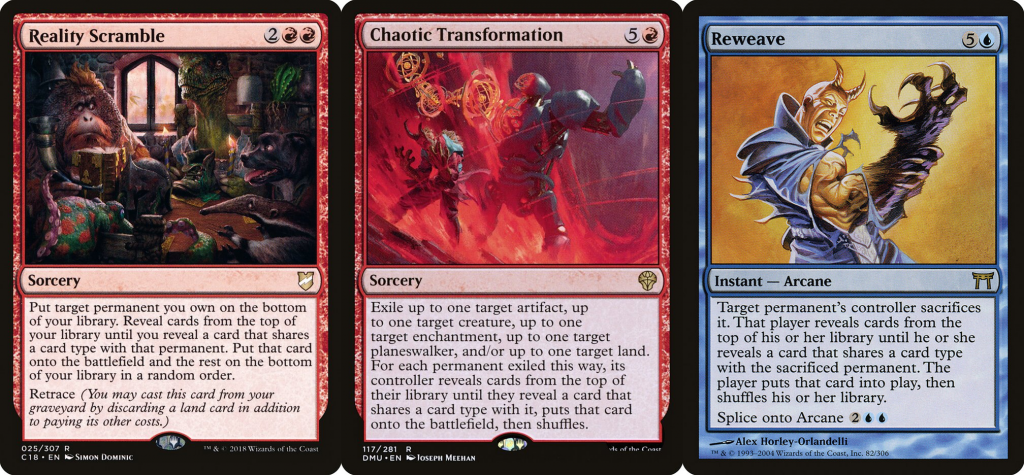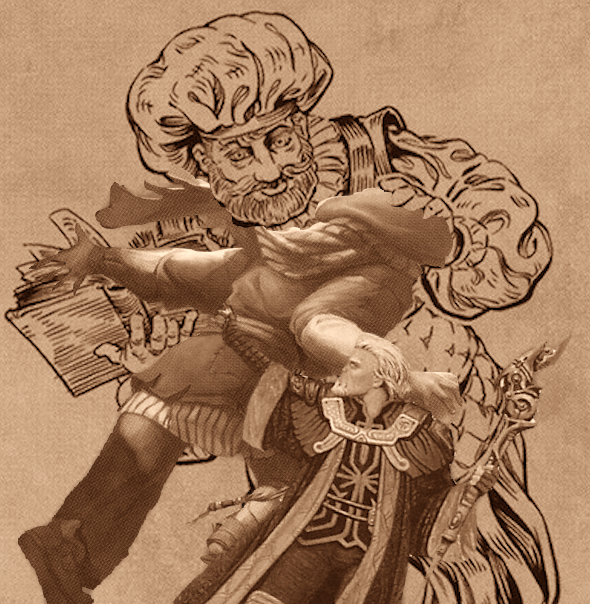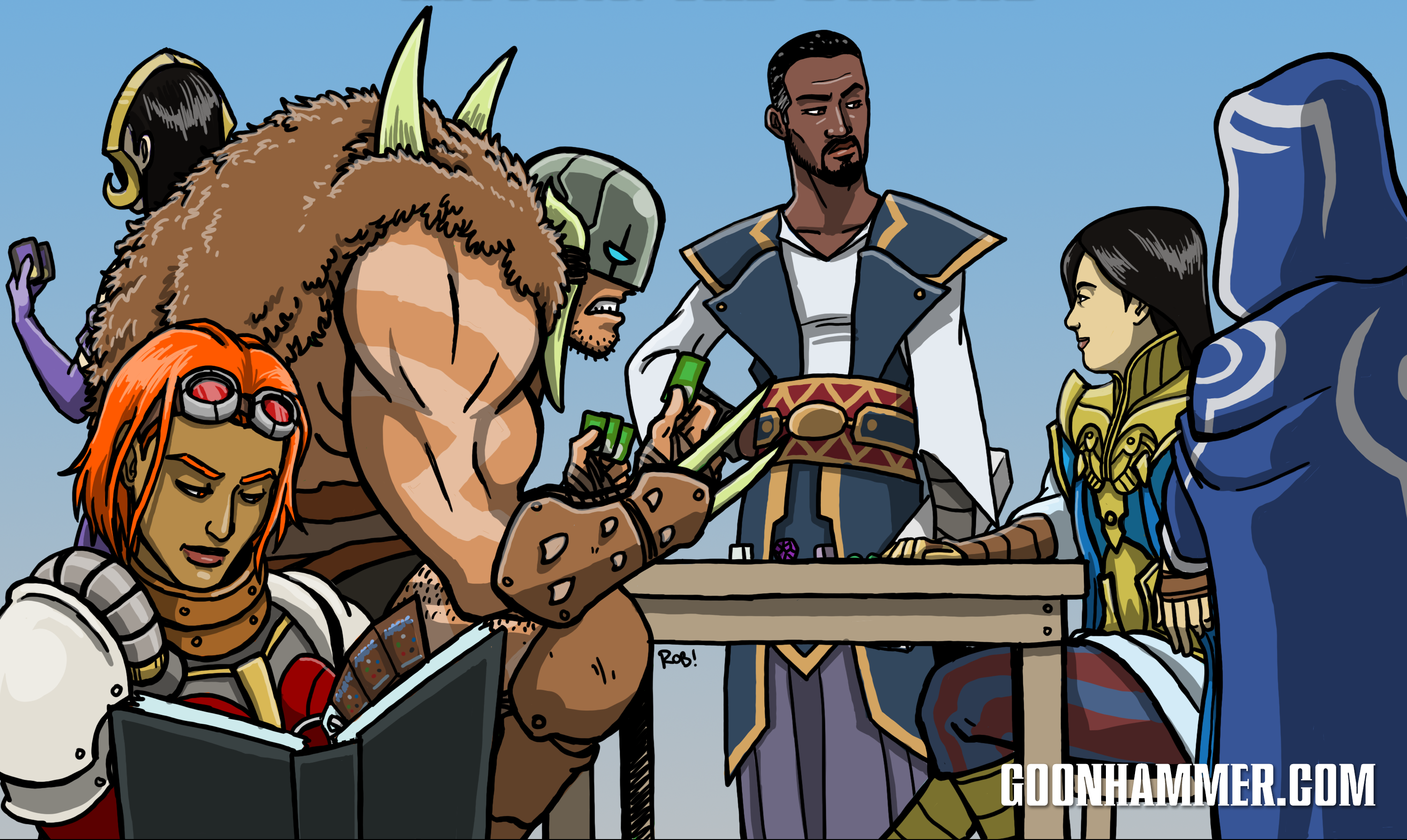The conceit of Commander is itself at-odds with the idea of optimal deckbuilding; no matter how much some commanders are pushed, there may always be another option that has some upside over the more niche option, causing players to gravitate towards cards or themes which are already popular. Especially in a format so wide, with such an unprecedented access to nearly every card ever printed, decision paralysis is doomed to set in when a deck’s vision is unfocused. This causes a sort of ‘feedback loop’ in game design, where the obvious buildarounds are built around in the face of overlong game history, and leads to the centralization of the game largely on tribal, specific combos, or perceived auto-includes that feel suboptimal to lack in ones’ deck.
Yet, what if I told you there are decks with Blue that can’t play Rhystic Study in order to function? Red decks that forego all but a few creatures, or artifact-centric commanders playing just one or two in the 99?
It’s time to talk about why you as a Commander play should try Polymorph (and/or Scramble) strategies.
A Brief History of the Archetype
First and foremost, some background: Polymorph, from which half of these strategies derive their name, was first printed in 1996’s Mirage, and allowed savvy deckbuilders to swap between creatures in a semi-random manner, by pivoting between what existed on your battlefield, and what creature(s) lurked near the top of your library. Reality Scramble, meanwhile, is the eponym for Scramble, the red-headed stepchild of Polymorph. Printed in Commander 2018, it could swap any permanent with one of a similar supertype off the top of your library, not just creatures; by technicality, however, Reweave is the true ancestor of this form of the strategy, having been printed in 2004’s oft-forgotten Champions of Kamigawa.
In theory, these cards are relatively fair, high-variance effects — under normal deckbuilding circumstances, you’re likely to swap what’s on board with something of similar-ish value, although the obvious highroll (or lowroll) potential is enticing. The trick of these cards in Commander’s modern landscape, however, is to play scant few options to potentially flip off the top of your library; if your entire deck only has your Commander, and one creature, you know for a fact you’ll be hitting that single option when Polymorph resolves. In a similar sense, Scrambling an artifact token for a non-token artifact in Deck, Background or Role for enchantment, or even something like Jeska, Thrice Reborn for a solitary Planeswalker all operate in a similar manner. Furthermore, from a competitive angle, this ensures your win condition isn’t cast, simply placed onto the battlefield following the relevant effect. If your opponent aims to interact, they’d need to commit before seeing the flipped card, and Scramble itself even has Retrace, in order to remain useful if countered or milled.
Especially in colors not including Black or Green, these effects often represent the best way to access permanent types that aren’t tutorable within the commander’s colors. Suddenly, Reality Scramble can allow an Izzet (Blue-Red) commander to find an Enchantment, or a Gruul (Red-Green) pairing to find a Planeswalker by using their Jeska. Naturally, the consistency of accessing these normally verboten permanent types is greatly reduced by playing multiple options, which guides Commander players to think about their deckbuilding in ways a normal list might not need to make concessions. Underworld Breach & Rhystic Study are both stellar cards, but unless your aim is to place them immediately on the battlefield at the cost of potentially not flipping into the actual target, they seem far less appealing.
This is the beauty of an opportunity cost: Weighing whether you gain or lose more by limiting yourself to just one or two of a given permanent type in your entire 99 is a tricky dance, and one that tests a deckbuilder’s creativity like little else.

Targets and Enablers
With all this in mind, you’re almost ready to begin assembling a deck that uses either Polymorph or Scramble as its linchpin strategy, but first, it’s worth going into some of the better targets, and how they’re accessed, among the major permanent types. As an aside, when one is speaking about flipping for a creature off the top of the library, that’s specifically a “Polymorph” effect, and for a non-creature, it’s a “Scramble.”
Creature
The classic enablers for Polymorph strategies are unique in that they contain an artifact, meaning Blue as a color can tap into their tutor-ability both as Sorceries, and artifacts. Polymorph, Transmodify, and Proteus Staff serve as the bedrock of the strategy, however, there are also Divergent Transformations, Chaos Mutation, and Guff Rewrites History as alternatives for Polymorph decks. In addition, the “universal” scrambles apply here, namely Reweave, Reality Scramble, & Chaotic Transformation. While it’s wisest to plan for the most condition-less Polymorph effects, there are certainly options for going all-in on such a gameplan.
In terms of what you’re usually searching for, the classic cEDH answer is a combination of Hullbreaker Horror and Tidespout Tyrant, which allow for a uniquely devastating control strategy that simply outpaces their opponents by playing the game normally. This is generally achieved via Urza, Lord High Artificer, who both creates a creature token and ramps mana into your early Polymorphs. That said, more niche strategies have emerged over time, such as with Minn, Wily Illusionist Polymorphing a token into Consecrated Sphinx for more consistent generation, or any number of partner pairings Polymorphing Rograkh into some other piece which gets them closer to their individual wincon. EG: Glint-Horn Buccaneer with Malcom, or “Secret Commander” lists with a threat like Godo, Bandit Warlord, but available in more than just Red alone.
If less targeted, and willing to slow down a tick, one can also play a sort of “Mass Polymorph” strategy, wherein a board of tokens or Partner Commanders flip into a set of multiple potent creatures. Go figure, Mass Polymorph is a great include for this strategy, as are Synthetic Destiny and the aforementioned Divergent Transformations, generally looking to assemble a 2-card creature combo on the resolution of one of these effects. While this can be even more powerful than a standard Polymorph or Scramble deck, it’s both slower, and more fragile, so proceed with caution. Some of the best commanders for this strategy are options like Kykar, Wind’s Fury, Magnus the Red, or Tevesh Szat, Doom of Fools and a Blue-Red Partner Commander.
Creature flips are both the most broadly accessible, and restrictive in terms of deckbuilding, of this general gameplan — while there are an absolute plethora of great options, and you nearly always have access to something available for Polymorph targeting, cutting down on creatures is a tough call, and oftentimes you’ll need to truly lean into some other gameplan, as is the case with Urza in artifact-based stax, or spellslinging control.

Enchantment
Enchantment is the second most common permanent type to use for this strategy, as the backbone of modern Scramble in Commander. These often take the form of Background commanders, where having a non-creature enchantment in the Command Zone allows for the easiest access of that type out of any option in Red and/or Blue. To that end, because you desperately want Red in your color identity, and Background options are only able to be 2-color at a maximum, the number of commander options is far fewer. Here, only the universal scrambles of Reality Scramble, Chaotic Transformation, & Reweave exist, but luckily Reality Scramble is an exceptional card regardless.
A scant few options have emerged as cEDH options within this sphere, but those that do exist are an absolute blast, and a great baseline for what one might do at a slightly lower power. Burakos, Party Leader/Guild Artisan with a target in Aggravated Assault is how I originally got into Scramble as an archetype, and it’s hard not to fall in love with a gimmicky Rakdos midrange deck that actually has teeth! In a similar vein, Abdel Adrian, Gorion’s Ward/Street Urchin with Meticulous Excavation can loop Dockside Extortionist and a whole lot more, with an inbuilt mana outlet in the command zone. As for slightly more spicy brews, my pet deck is Volo, Itinerant Scholar/Street Urchin with Mind Over Matter, as a means to draw the deck, make infinite mana, and kill the table with a shockingly resilient midrange deck.
That said, Backgrounds as a whole are quite unpopular, and there’s pieces yet to really be touched. Karlach, Fury of Avernus comes to mind, as does Passionate Archaeologist as a potential kill condition with Food Chain in Gruul, and really nearly any non-Red Commander with Choose a Background may have teeth. Guild Artisan as a means to accelerate and Street Urchin as a way to often kill using infinite mana/pieces on board, both strike me as some of the best overall Scramble targets out there, and each grants Red at a decently fast mana value of 2.

Artifact & Planeswalker
Artifacts exist in an odd space within Scramble’s wider net, as the colors that have access to Scramble effects also have the best access, and greatest need, for artifacts. In order to remain competitive within the pace of the game, therefore, you would likely need access to Green for land and creature-based ramp, which is why we’ve not yet seen a cEDH list that scrambles through artifacts at this time. That said, there’s certainly a commander brimming with potential for such a strategy: Lara Croft, Tomb Raider. Lara not only makes Treasure, as noncreature artifacts, has access to Red, Blue, and Green, but also allows for an absolutely adorable gameplan of Scrambling into Mycosynth Lattice (and/or, if not rude, Encroaching Mycosynth). This then allows you to use cards like Vandalblast to wipe the opposing boards, shut down land abilities with Karn, the Great Creator, or do a bit of both with Red Sun’s Twilight. Artifact Scramble has access, as well, to Shape Anew, and if you’re planning for both creatures and artifacts, Indomitable Creativity.
Planeswalkers are slightly more realistic, and make up the bulk of your remaining Polymorph/Scramble strategies. As mentioned, Jeska, Thrice Reborn is a stellar option, and you can essentially play classic Teferi, Temporal Archmage + Chain Veil in up to 3 colors in that way, or pivot into Professor Onyx for an infinite copy line to kill the table. Dihada, Binder of Wills is similar in Mardu colors, but critically also represents quite a lot of acceleration if she’s allowed to survive, and can couple with multi-Scramblers such as Chaotic Transformation to pivot through both Planeswalker and Artifact for the entire Karn + Lattice combo itself, although this requires a severe warping of ones’ deck. Lord Windgrace also brings up the rear, although to many he’s just worse than either Green-Black Partner + Jeska. One especially funny line is Scrambling off of Jeska into Lukka, Coppercoat Outcast, who can then Polymorph your Partner creature Commander. Hijinks ensue.
Land & Battle
There’s not really a need to Scramble for either of these types, as they’re either far more accessible in other ways, or no option yet exists that’s worth Scrambling into (in the case of Battles).
So Now What?
What you’ll notice about all of the choices made here is that there’s three things prioritized: 1. An obvious win condition once the Polymorph/Scramble effect resolves, 2. Some portion of that condition exists in the Command Zone (Infinite mana outlet, damage or mill, etc), 3. The flipped portion of the win condition is not already easily accessible outside of Poly/Scramble. While something like Omniscience looks shiny and delicious as something to scramble into, only in rare cases does it result in an obvious route to immediate victory, rather than the capability to twiddle ones’ thumbs more efficiently than you did before. Cards like Food Chain, Aggravated Assault, Underworld Breach, etc tend to be higher up on the totem pole, as they’re far more immediately impactful.
Now that you hopefully have a grasp on how these strategies play out, I’ve created a checklist to gauge whether it might be worthwhile to play a specific commander as a Polymorph or Scramble deck.
- Does your commander include at least Red and/or Blue in its color identity?
- Yes: Move to 2. (Enchantment & Planeswalker Scrambles are only available in Red, aside from exactly Reweave)
- No: Move to 4.
- Does your commander include an ability to easily create a token containing one relevant permanent type, OR is one or more of your commanders a non-creature of the relevant permanent type?
- Yes: Move to 3. (Notably, Rograkh, Son of Rohgahh bucks this trend by being both in Red, and mana value 0, meaning it’s an excellent Polymorph target)
- No: Move to 4.
- Does your specific flip choice for a Polymorph/Scramble either win the game upon resolution with conditions met, OR place you so far ahead of your opponents that victory is highly likely?
- Yes: Congratulations, you should consider this commander within the context of Polymorph/Scramble.
- No: Move to 4.
- The opportunity cost associated with playing a Polymorph/Scramble strategy with this Commander is likely worse than if you played either multiple decent-but-not-winning flip choices, or abandoned the strategy.
You can certainly play Commanders with Polymorph/Scramble elements that aren’t dedicated to the strategy, such as with Neera, Wild Mage or other similar ‘hit a big thing’ decks, but the power behind playing a dedicated, limited choice for what you intend to hit off of a flip can greatly boost a deck’s capabilities, and win games out of nowhere.
Example Decklist: Volo, Itinerant Scholar/Street Urchin
As I mentioned in the Enchantment section, my true pet deck, that I see myself playing for all time, is headed by “Background Volo”, as opposed to his more popular single-Commander twin. I feel as though this list best showcases what a Scramble deck can be capable of, especially insofar as how a deckbuilder is pushed to restrict what can be played by the very function of a strategy itself. It’s worth prefacing what the deck is trying to achieve — the combination of any creature, artifact, or land that taps for 2 or more mana, Volo with ≥2 creature types marked in his Journal, and Mind Over Matter will allow a player to draw essentially through their library, at which point one of many infinite mana combos (Rings of Brighthearth + a Monolith is the obvious) alongside a way to generate infinite creatures or artifacts (Treasure Vault or James, Wandering Dad // Follow Him) will kill the table via Street Urchin. This sounds exceptionally convoluted, especially in Blue-Red, but everything in this article speaks to the reasonable capability to achieve this board state.
Playing a variety of Bouncelands such as Izzet Boilerworks and the like can readily cover the need for a permanent that taps for 2 mana, and likewise, nearly all competent mana rocks do the same. The deck can only play one enchantment, so many of the best effects granted by those missing cards have to be achieved via creatures, which in turn help to fuel the Volo’s Journal token. Finally, with an enchantment in the Command Zone giving us access to Red, and being a means to kill the table with infinite mana, it makes far more sense to Scramble into Mind Over Matter than find it in other ways, being nearly otherwise impossible in the colors.

Like a lot of endlessly tunable decks, the simultaneous broadness and specificity of this list — asking only for some of the best creatures in Red & Blue, but also within the constraints surrounding enchantments, and otherwise limited space — just keeps me coming back for more, and I would wager quite a lot of Polymorph/Scramble lists are similar.
In Conclusion
I leave you with this: Fitting in some degree of Polymorph/Scramble into an archetype that normally lacks it can truly be one of the most fun things you can do in Commander. Imagine a take on Energy headed by Lae’zel, Vlaakith’s Champion, flipping into the brand-new Aether Revolt! Want a storm enabler but don’t want to find it? Maybe flip your way into a Ral, Crackling Wit; after all, your list might not even play other planeswalkers anyway.
Restrictions breed creativity, and the number of posts that people make musing wistfully about having non-standard permanents as Commanders is frankly too high not to offer a recommendation of Polymorph or Scramble, at this point. Between all the Scrambling and flipping, brewing and cooking, you’ve practically got a balanced breakfast.
Have any questions or feedback? Drop us a note in the comments below or email us at contact@goonhammer.com. Want articles like this linked in your inbox every Monday morning? Sign up for our newsletter. And don’t forget that you can support us on Patreon for backer rewards like early video content, Administratum access, an ad-free experience on our website and more.


